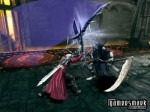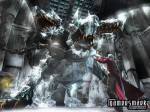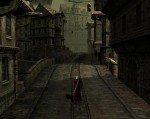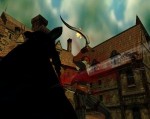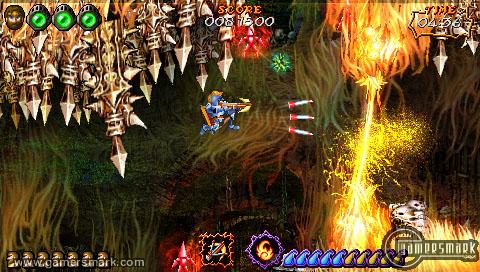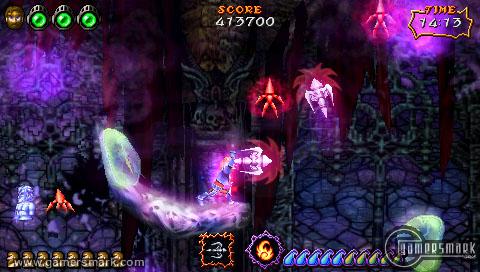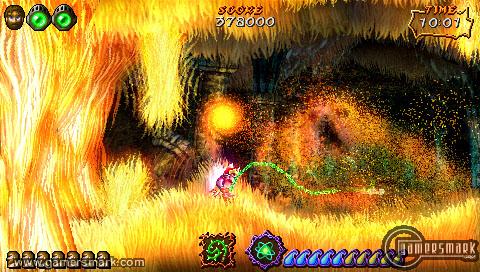Developer/Publisher: Capcom || Overall: 9.0/10
The Devil May Cry series has been one of the more talked about games recently with the release of Devil May Cry 4, all with the exclusivity to Sony platform being thrown up into the air – but back in the day where none of that mattered, there was a game called Devil May Cry 3: Special Edition for the PS2. The Special Edition is the refining of the original game, Devil May Cry 3: Dante’s Awakening, and includes a bunch more goodies that the first version didn’t have, as well as a shuffling around of the difficulty modes. Usually action games peak out around ten or fifteen hours, but it’s easy to spend at least twice that with Devil May Cry 3: Special Edition.
Put simply, Devil May Cry 3 is an action game with horror and gothic elements. It’s not exactly scary, but the game goes back to its roots after Devil May Cry 2’s “offensive” locale. Not only that, but there is an actual story that you can comprehend, unlike any of the other games in the series up to this point. Though the story is actually worth its weight in words this time around, the main appeal comes from the gameplay itself, and it speaks volumes. Unlike most games, Normal mode isn’t for the faint of heart, and even that is considered “easy” by the original version of Devil May Cry 3’s standards.
The Devil May Cry series doesn’t have a combo system utilizing different buttons like in God of War. There is one button to use your melee weapon (typically a sword), one button for your guns, and one button for a special move. Used appropriately, you can string together all the different types of attacks to lay some serious hurt on the demons and rack up some impressive combos. Unlike Devil May Cry 2, you’ll have to hit the square button over and over if you want to shoot Dante’s guns (in Devil May Cry 2, you could just hold it down and it’d fire). As far as Dante’s pistols go, the faster you hit the square button, the faster he’ll shoot them. As you get different weapons, they all have their own firing rates, so clicking the button as fast as you are able to does not help you all the time. Melee weapons follow a bit different logic, however. A melee weapon has two or three different combos that rely on the timing of your button pushes. This can change a little from weapon to weapon, but it’s basically the same execution. In total, there are five guns and five melee weapons for Dante to acquire through the game.
The circle button comes into play when you want to use one of Dante’s Styles. The basic styles are Trickster, Swordmaster, Gunslinger, and Royalguard. Trickster allows you to make use of dashing and running up walls, which I found to be practically useless. Trickster is a hold-over from the circle-button command from Devil May Cry 2, but Devil May Cry 2’s execution in that regard was leagues better. Swordmaster is a bit more useful, and allows you to do some cool stuff with your sword (like throw it) once it levels up. Gunslinger is the one I used the most, and allows you to do quite a few things, like shoot your guns faster, charge them, and target two targets at the same time. Not to mention spin in the air like a tornado while shooting your gun! Gunslinger is by far the coolest of all the styles. Royalguard is kinda boring and only blocks. If you block enough, you charge up some power and can release it onto an enemy to kill them. It’s sort of ineffective at times, because you’ll still get damaged, and it’s not really smart to take damage since it’s very hard to find something that heals you. Other styles are acquired as the game goes on, but for about 80 percent of the game you’ll be stuck with those four. The more advanced styles you gain later on don’t allow you to level up at all.
The graphics are pretty nice for a PS2 game, but do sort of show their age as we get further into the current generation of consoles. The voice acting is not terrible at all, so that is something to be thankful for. The sound effects are good, but the music is where the game lacks. Every time you’re near an enemy, a cheesy battle score with horrible lyrics starts playing. I hated the song by the end of the game and tried to just ignore it, unfortunately to no avail. It would have been nice if they didn’t have such a horrible song, but what can you do? The story is good, and really the first competent piece of writing the series has shown after the first two games.
Overall, the game is very hard, even at the Normal difficulty. The easy difficulty allows for less experienced action gamers (or people who just suck at games) to get into the game to actually beat it and *gasp* enjoy it. Even hardcore gamers will probably at least take a pass through all modes of play the game has to offer, as it’ll add towards fully completing the game in every facet. Once you finish the game, a new gameplay mode called Bloody Palace will be accessible, not to mention being able to play as Dante’s brother Vergil in a new game. There’s plenty of stuff to unlock, so you’ll be playing the full game quite a few times, although it’ll be easier after the first time since you’ll know how to figure out all the puzzles.
Devil May Cry 3: Special Edition is a good game to play if you’re into action games. Since it has been out for a while now, you’ll be able to find it at a very cheap price. The Devil May Cry box set includes all three of the PS2 games in the series, and it’s a good value. Regardless of your feelings toward the second game, you’ll get a loaded action game in Devil May Cry 3: Special Edition.

